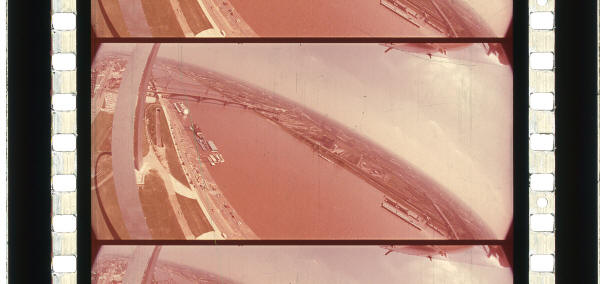Introduction to Cinema 180 |
Read more at in70mm.com The 70mm Newsletter |
| Written by: Thomas Hauerslev, based on newspaper clippings, information and brochures from Omni Films, 1990 | Date: 05.03.2021 |
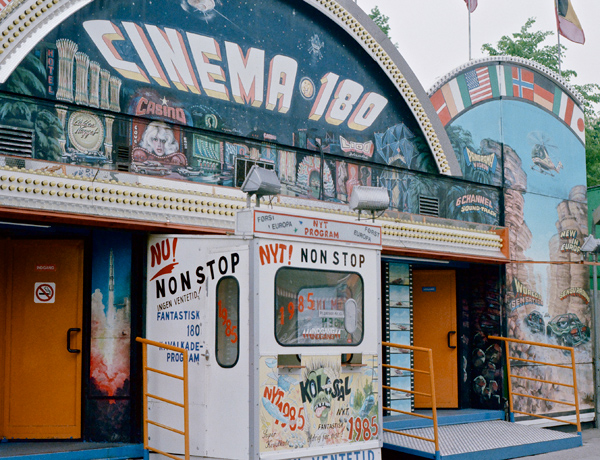 One
of four Danish Cinema 180 installations. Installed in
early 1980s at Dyrehavsbakken, north of Copenhagen (DK). Picture by Thomas Hauerslev One
of four Danish Cinema 180 installations. Installed in
early 1980s at Dyrehavsbakken, north of Copenhagen (DK). Picture by Thomas HauerslevIf you browse through the history of the various large image "Scopes", "Ramas" and "Visions" cinematic processes, certainly "Cinema 180" would seem to be the obvious candidate for being the most fun of them all. Cinema 180 was a direct extension of Cinerama (1952) and Todd-AO (1955), both large format projection systems, both of which pioneered audience participation, and gave the spectators an authentic "you are there" illusion. Go to in70mm.com's Todd-AO Page Go to in70mm.com's Cinerama page Pronounced "Cinema One-Eighty", the process was the most honest "First Person" thrill-ride you could imagine on 70mm film. Roller coasters, fire trucks, speed boats, motorcycles and airplanes: mount a 65mm camera very low and in the front, and then go as fast as you can. Fly through deep narrow canyons, speed through narrow streets, ride trains on high mountain rails, or drive on an expressway at high speed. Photograph it with short focal lenses, to exaggerate the speed and perspective, and the illusion of reality will put the audience "in the picture". Cinema 180 ride films were shown in 70mm on the inside of a huge 180 degree screen domed structure. There was typically no seating in most cinemas, the audience would be standing in front of the screen. The screen went from side to side, and all the way up from the floor to the top of the dome. Cinema 180 cinemas were typically installed at: Amusement parks, Theme and Recreation Parks World's Fairs and Expositions Trade Shows, Museums, Planetariums, Shopping Malls With a running time of only about 10-13 minutes for each film, it was enough to give the audience an impressive immersive "right in the gut" experience, which often challenged their balance and orientation. Here in Copenhagen (and elsewhere) it was not uncommon to see people fall during performances. They might have enjoyed a bit too much to drink in Copenhagen's Tivoli Gardens or at Dyrehavsbakken, and could easily become overwhelmed by the large image and loose their balance. They simply became dizzy from the spectacular action on the domed screen. It was a very popular and entertaining cinema experience throughout the late '70s and through the '80s. The characteristic and colourful "tent" attractions were installed all over the world. Cinema 180 was installed in the North- and South America, the Far East, the Middle East, Europe and Australia / New Zealand. At the peak, some 175 theatres operated around the world. They were cost effective, easy to maintain and mobile so they could go where the crowds were. This is how the company presented itself: "OMNI Films International, Inc. designs, sells and installs 70MM wide-screen cinema and motion simulation theater systems to independent exhibitors. The systems are used in amusement and theme parks and other specialized markets. In addition, Omni Films International Inc produces and licenses films for use in their systems to companies worldwide on a continual basis."
Go to Cinema 180 in
Denmark |
More in 70mm reading: Cinema 180 Films including OmniVision Specialty Films, MagnaVision, OmniVision, MotionMaster and ESI 3D PDF: iWERKS / Cinema 180 theatre list (1996) Cinema 180 in Denmark iWERKS Showscan |
|
Fred Hollingsworth III
(Jan 15, 1930 - Mar 18, 2018) was the president and founder of Omnivision, Inc. (in Florida,
USA), and is considered
to be the father of film-based attractions. He was an internationally-known creator
and manufacturer of Cinema 180, Motion Master, Omnivision, Magnavision and
ESI-3D. He pioneered
the design and manufacture of entertainment attractions for nearly four
decades. He was the pioneer in recognizing the revolutionary entertainment
potential of 70mm film.
He literally invented amusement park theatres
and designed the Cinema 180 attraction in 1974. It was called Cinema
180 because it was 70mm film
projected onto a 180 degree dome screen.
Cinema 180 was the first kind of theatre to exist almost specifically for amusement parks. He put the
audience in the middle of the imagery and surrounded them in the
film experience. |
|
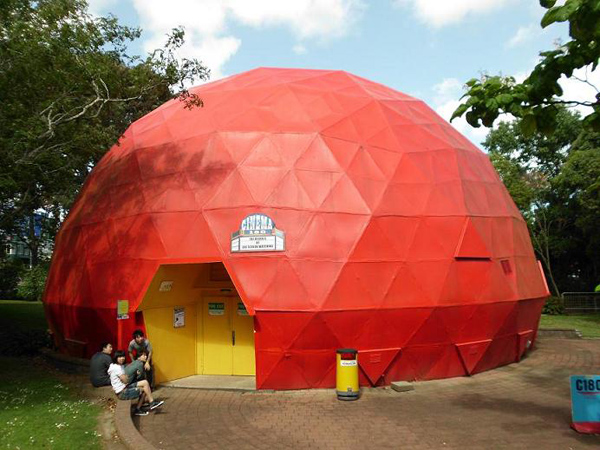 The last known operational cinema of this
kind was apparently the Cinema 180 at Rainbow's End in Auckland Theme Park (New
Zealand), which closed in 2015. It had originally opened in 1983. Picture by Cameron Glendinning. The last known operational cinema of this
kind was apparently the Cinema 180 at Rainbow's End in Auckland Theme Park (New
Zealand), which closed in 2015. It had originally opened in 1983. Picture by Cameron Glendinning.The library of film consisted of 15 different titles each with a 13 minute running time. Narration could be produced in every language requested or only with music and effects. All films were with 6 channels magnetic soundtrack in format 5/70mm (5-perf pull down) in either 24 or 30 frames per sec. This also applied for the 8-perf system with 24 or 30 fps. that was used for Magnavision, Omnivision and Motion Master systems. Cinema 180 titles were flashy and catching like "Crazy Wheels", "Flight 747", "Wild Wild West", "International Thrill Show", "Demon Shock", "Galaxy of Thrills", "Fantastic Flights" and "Pacific Pursuit". Basically the same type of scenes in all productions except they were photographed in different places. "Galaxy of Thrills" was built up by 11 scenes in lengths from 20 seconds to 90 seconds. See the full breakdown of scenes below. All Cinema 180 titles were produced by Omni Films Int., Inc. with camera-equipment from other suppliers. Two original M.C.S.-70 65mm cameras of West German origin were purchased by Omnivision Inc. and used to photograph Cinema 180. Go to Cinema 180, OmniVision Specialty Films, MagnaVision, OmniVision, MotionMaster and ESI 3D Go to The M.C.S.-70 Process and European Cinema of the 1960s Here is a breakdown of scenes from the Cinema 180 production "Galaxy of Thrills", as it was presented in Tivoli Gardens, Copenhagen in the 1980s. OmniVision presents In Cinema 180. Produced by Fred Hollingsworth III and Richard Marchant. Shelton Productions. 11 sequences, running time 11 minutes, 377 meters / 1238 ft. German narration, no DK subtitles 01:30 Roller Coaster 00:58 Race cars 00:22 Skate board 00:59 Fire truck in suburb 01:28 Roller coaster II 00:44 Race cars track 00:26 Hawaii surf 01:20 Hawaii airplane 00:47 Swing 00:40 London 01:46 Monte Carlo |
|
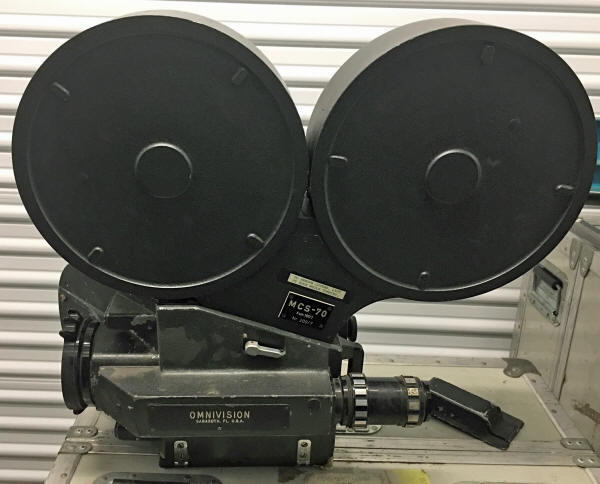 Two
original MCS-70 65mm cameras of West German origin were purchased by
Omnivision Inc. and used to photograph Cinema 180. Picture by Scott Shepley Two
original MCS-70 65mm cameras of West German origin were purchased by
Omnivision Inc. and used to photograph Cinema 180. Picture by Scott ShepleyThis is how Omni Films presented the synopsis:
Omnivision also licensed the use of 65mm footage to other productions. "Brainstorm"
(MGM 1983) produced and directed by
Douglas Trumbull, features
eleven point of view scenes from Omni Films movie library including the
"Loch Ness Monster", roller coaster, Lake Placid bobsled run, snowmobiling
in Utah, Grand Canyon, Golden Gate Bridge, surfboarding, and a runaway
tractor trailer.
Some "Brainstorm"
scenes is photographed with an OmniVision fish-eye lens (designed by Milt
Laikin), almost similar to the Cinerama Fairchild-Curtis 160-degree 2
ultra wide-angle lens, which was also used for many wide angle shots on
Stanley Kubrick's "2OO1: A
Space Odyssey" (MGM 1968).
Omnivision, Inc. and its subsidiary Omni Films International, Inc. were
operational from 1976 until 1994, and operated as a full service 70mm film
company, with complete production facilities.
Omni Films was recognized worldwide for its award-winning technological
achievements. Omni Films' five and eight perforation 70mm formats expanded the
traditional film image to totally encompass and involve audiences, creating
the sensation that they are actually part of the action. An Omni Films
"You Are There" theater experience enthralled audiences, guaranteeing
positive recommendations and repeat visits. |
|
 Fred Hollingsworth III,
President and Founder of Omni Films International, Inc. Picture from
Omni Film's presentation folder Fred Hollingsworth III,
President and Founder of Omni Films International, Inc. Picture from
Omni Film's presentation folderIn Germany Cinema 180 films were also produced under the name Cinevision / Cinema 2000 by Udo Kaup (1942). In an e-mail to the editor in February 2021, his son Marcel Kaup writes:
The last known operational cinema of this
kind was apparently the Cinema 180 at Rainbow's End in Auckland Theme Park (New
Zealand), which closed in 2015. It had opened in 1983, and after 32 years of
operation, the entire installation, including the Philips DP75 projector, was
sold to enthusiasts on eBay.
The legacy of Fred Hollingsworth III still
lives in the memory of the audiences who saw the films. Old faded 70mm
prints still surfaces on eBay from time to time when they change hands
between collectors here and there. Sometimes vintage Cinema 180 films are shown at 70mm
festivals in Karlsruhe (Germany)
and Krnov (Czech Republic)
as a welcome surprise. Only this time - the audience is sitting down in
comfortable chairs, and will not fall over. |
|
Cinema 180 Product information |
|
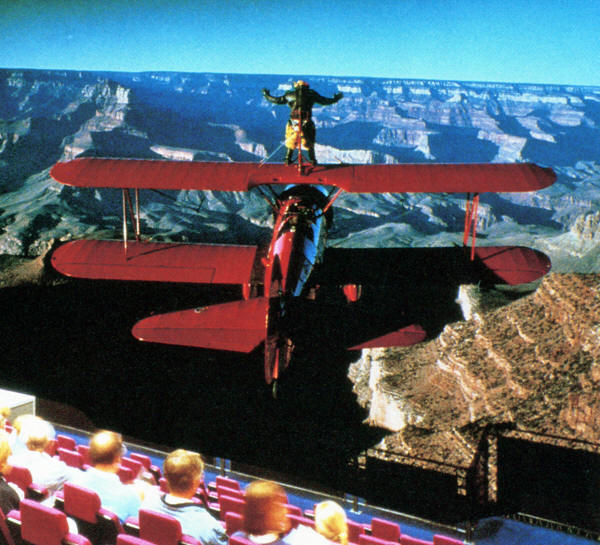 Picture
from Omni Film's presentation folder Picture
from Omni Film's presentation folderThe Cinema 180 Theater Dome structure consists of a heavy-duty, flame resistant, vinyl-coated polyester roof and sidewall membrane tensioned over a galvanized steel frame. A quadrispherically shaped negative-pressure membrane projection screen attaches and seals to the frame and concrete floor. A blower located between the rear of the projection screen and the roof and sidewall membrane creates a negative pressure on the back side of the screen, causing it to take its proper quadrispheric shape. Cinema 180 Theater Systems, available in four standard sizes, are specifically designed to exhibit Cinema 180. Cinema 180 Theatre Systems were available in four standard sizes. Model 55A 275 / 100 standing/seated Screen 12,80 m. 7,93 meter height. 5,49 meter depth Model 72A 425 / 160 standing/seated Screen 15,24 m. 7,93 meter height. 6,4 meter depth Model 55XL 500 / 150 standing/seated Model 72XL 625 / 250 standing/seated People per hour with three 12 minute shows pr hour Standing/Seated 825 / 200 1275 / 480 1500 / 450 1875 / 750 |
|
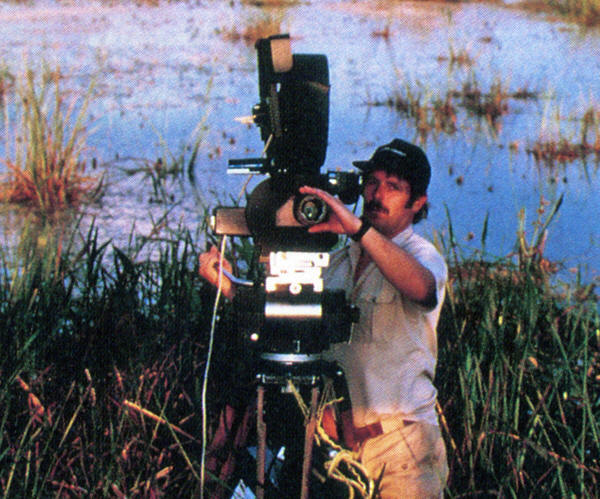 Omni Films International camera crews challenge the impossible. They strap
themselves onto helicopters, challenge rapids, race cars, go up, down, in
and out of impossible places for a whole new point of view. Jeff Simon,
who's credit include "Magic Florida. Picture from
Omni Film's presentation folder Omni Films International camera crews challenge the impossible. They strap
themselves onto helicopters, challenge rapids, race cars, go up, down, in
and out of impossible places for a whole new point of view. Jeff Simon,
who's credit include "Magic Florida. Picture from
Omni Film's presentation folderOperating personnel One projectionist One Usher on high traffic days Equipment Supplied: Cinema 180 Projection Systems Cinema 180 Lens Theater Structures with Screens for new installations Frame Supported Screens for existing structures Mobile Trailer Mounted Theaters Omnisound System - 6 Channels Options: Continuous Loop Film Cabinet Film Platter Mobile Air Conditioner Ticket Box Portable Foundation Decorative Facade Power Roof Ventilator Custom Exterior Color for Theater Structure The Power of Presentation We write, produce and package the spectacular to hold your audience by their eyes and ears and make them yours. Surround and stimulate their senses with excitement and emotion. Take them for an unbelievable ride from the ocean floor to mountaintops. Tell your corporate story, put your product on a pedestal, or sway audiences to your point of view. A Complete Service We provide the production, the technology, the cinematic hardware, the theater. Omni Films International cinematic experience and unique 70mm film technology is available nowhere else. Position your program where you need it. We do the rest. Then, take it on the road, exhibit at a convention center, convert an existing structure or choose from a broad range of permanent theater buildings custom designed for minimal maintenance and maximum traffic flow. |
|
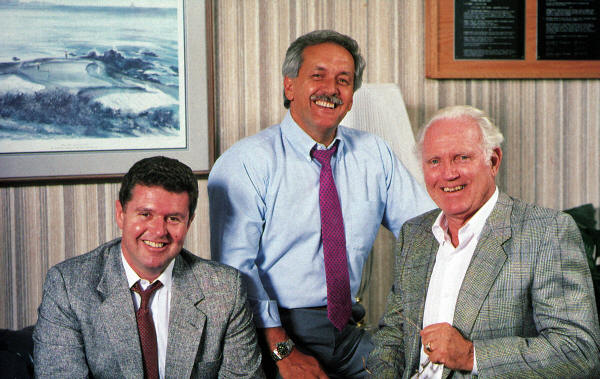 Left
to right: Fitz-Edward Otis (Vice President of Marketing and Sales), Julian
Angus (Vice President of Engineering) and Fred Hollingsworth III (President
and Founder). Picture from Omni Film's presentation folder Left
to right: Fitz-Edward Otis (Vice President of Marketing and Sales), Julian
Angus (Vice President of Engineering) and Fred Hollingsworth III (President
and Founder). Picture from Omni Film's presentation folderA Bold New Approach to Cinematography Omni Films International camera crews challenge the impossible. They strap themselves onto helicopters, challenge rapids, race cars, go up, down, in and out of impossible places for a whole new point of view. Combined with one-of-a-kind camera equipment, the unique becomes unforgettable and the unforgettable, spectacular. Your audience is thrilled, startled, stunned and ready for more. Our ability to draw an audience, to hold them riveted, to sell them again and again is a proven commodity, whether you choose from our library of high adventures, or commission us to create a 70mm production that's exclusively yours. Types of cinemas: Cinema 180 (Resembling the Gunnery Trainer of the '40s), MotionMaster, 3D, OmniVision. All over the world we have over 100 theaters showing Cinema 180 still in operation. In Denmark we had in the past four units in operation. Four cinemas in Denmark plus one MotionMaster. Cinema 180ฎ: Surround your audience with captivating color, action and sound. Memorable minutes of "being there" transport you from one dramatic and electrifying experience to another. Exhibit this enormously successful 70mm film in a theater configuration designed to meet your space, mobility and budget requirements. Dimension36Oฎ: A startling visual effect featuring 360 degrees of action on a dome screen that opens the world from horizon to horizon. Our 70mm, single projector system is the technical marvel that makes it happen. MagnaVision: Magnavision's giant 6-story screen transforms a stadium, arena or convention center into an astonishing media event. Your production will have resolution and color intensity never before achieved on screens of this magnitude. Turn your imagination loose. ESI-3D: Enhanced Spatial Imaging. A 70mm, 3-D effect that explodes off the screen into the audience. This single-camera/projector 3-D technology reaches beyond anything ever seen before. A guaranteed crowd pleaser that brings them back again and again. |
|
Complete Documentation |
|
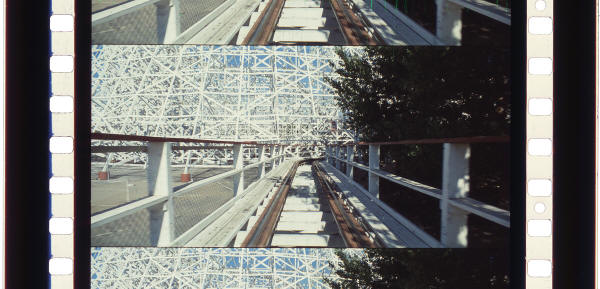 70mm
frame 70mm
frameAll OmniVision 70mm film- and theater-systems. PDF Material Supplied by Omni Films, 1990: PDF 1986: Cinema 180 Dimension 360 ESI 3D MagnaVision PDF 1990: Cinema 180 Cinema 180 Technical Data Cinema 180 Film Descriptions ESI 3-D with film description ESI 3D Film MagnaVision with Film Library MagnaVision Film MotionMaster with film programs OmniVision with Film Library OmniVision Film |
|
Production Facilities |
|
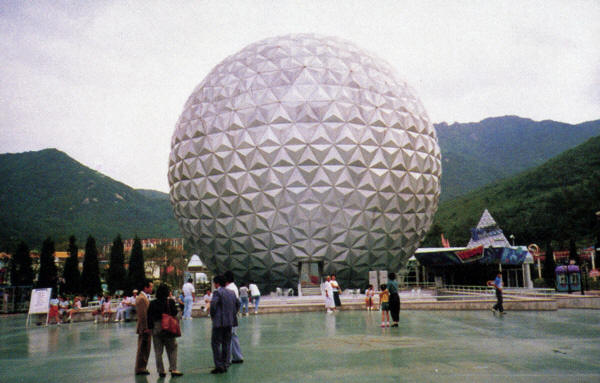 Magnavision's giant 6-story screen transforms a stadium, arena or convention
center into an astonishing media event. Your production will have resolution
and color intensity never before achieved on screens of this magnitude. Turn
your imagination loose. Picture from Omni Film's presentation folder Magnavision's giant 6-story screen transforms a stadium, arena or convention
center into an astonishing media event. Your production will have resolution
and color intensity never before achieved on screens of this magnitude. Turn
your imagination loose. Picture from Omni Film's presentation folderCamera format: All films are produced with 65mm camera's owned by Omni and produced by Omni. PROJECTION Ultra-high resolution and crisp, bright images are the Omni Films standard. Omni Films' precision projection systems can be customized to meet your specific needs and applications: 570 and 870 formats 24 and 30 frames per second 4 to 12 KW xenon projection light sources HARDWARE AND SOFTWARE Extensive film libraries Custom film production Optical printing equipment for 1570/870 transfer with full frame integrity maintained Camera rentals for film production Permanent or temporary theaters Endless-loop projection cabinets for labor efficient operation and extended film life Seating layouts conforming to your design requirements Show controls Special in-theater effects Omni Films International, Inc Projectors: are Ballantyne projectors with Rentec lamphouse. Lamp-capacity 2500 W, 4500 W, 7000 W or 12.000 W (latest is water-cooled). Favorit 70 and Victoria 8 in Denmark. Technology Simplified. Sophisticated 70mm film projection technology integrated into a simplified, easy to manage system, can be operated by one person. Just plug it in and push a button. |
|
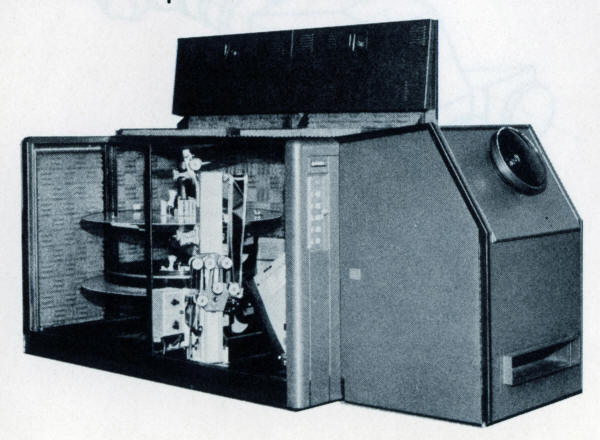 Enclosed
70mm projector with endless loop 70mm print. Picture from Omni Film's
presentation folder Enclosed
70mm projector with endless loop 70mm print. Picture from Omni Film's
presentation folderAdvanced Optics. Your picture soars above and beyond the limits of peripheral vision. Proprietary custom lenses make it possible to project onto a variety of imaginative screen configurations from flat to spherical. No multi-camera trickery. No split screens. An unforgettable experience for everyone who sees it. OmniSoundฎ To enhance this extra-ordinary 70mm film experience, a powerful audio system takes multi-track sound technology to the limit. Clean, transparent. Why 70MM? The 70mm film frame is 400 percent larger than 35mm. No other film format offers the opportunity to deliver such massive amounts of visual information with so much sharpness, color saturation and brightness. The Power of Presentation We write, produce and package the spectacular to hold your audience by their eyes and ears and make them yours. Surround and stimulate their senses with excitement and emotion. Take them for an unbelievable ride from the ocean floor to mountaintops. Tell your corporate story, put your product on a pedestal, or sway audiences to your point of view. Year of Magic Join the hundreds of imaginative business people around the world who have millions of happy viewers coming back for more and more. Practical, professional, frontline experience assures you of a successful, cost-efficient film presentation and theater system. Our team consists of skilled, technical innovators and creative filmmakers, dedicated to commanding an audience's attention. A Complete Service We provide the production, the technology, the cinematic hardware, the theater. Omni Films International cinematic experience and unique 70mm film technology is available nowhere else. Position your program where you need it. We do the rest. Then, take it on the road, exhibit at a convention center, convert an existing structure or choose from a broad range of permanent theater buildings custom designed for minimal maintenance and maximum traffic flow. |
|
| Go: back - top - back issues - news index Updated 21-01-24 |

